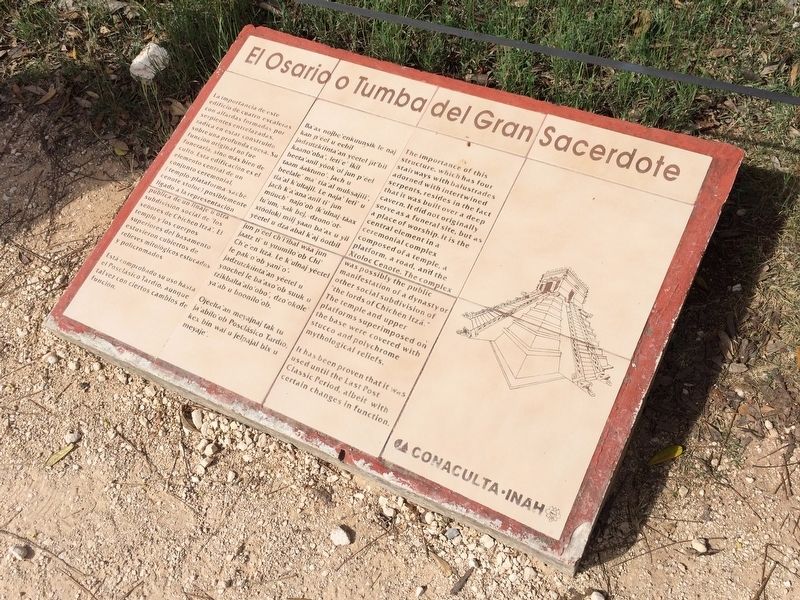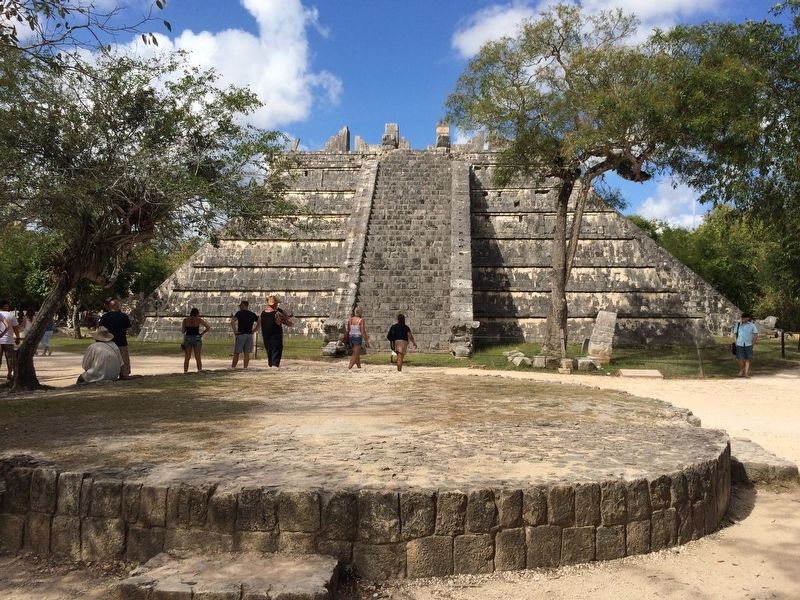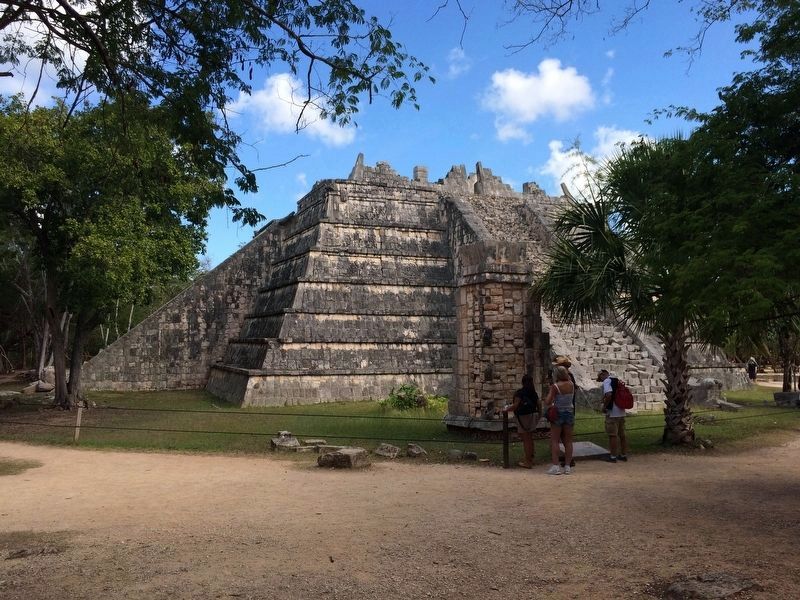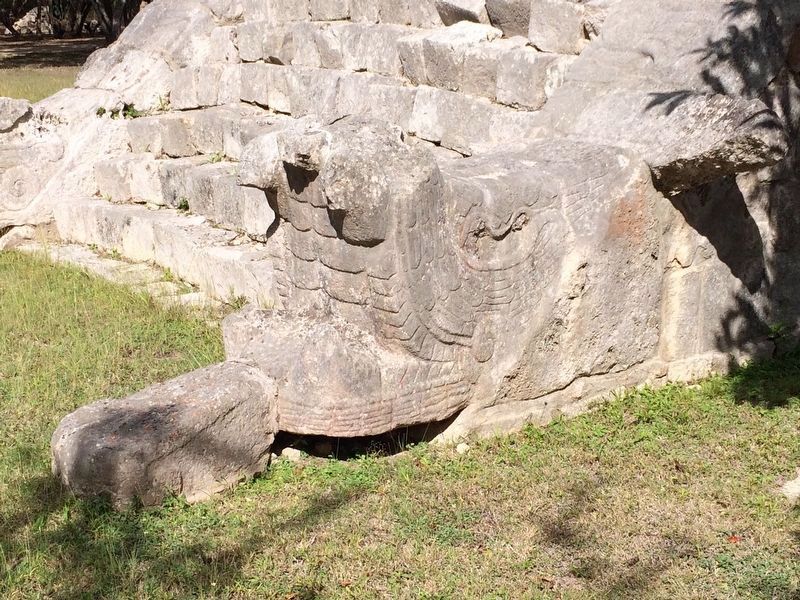Pisté in Tinum, Yucatán, Mexico — The Southeast (Yucatan Peninsula)
The Ossuary or Tomb of the Great Priest
Inscription.
El Osario o Tumba del Gran Sacerdote
La importancia de este edificio de cuatro escaleras con alfardas formadas por serpientes entrelazadas, radica en estar construido sobre una profunda cueva. Su función original no fue funeraria, sino más bien de culto. Esta edificación es el elemento central de un conjunto ceremonial, (templo-plataforma-sacbé-cenote xtoloc) posiblemente ligado a la representación pública de un linaje u otra subdivisión social de “los señores de Chichén Itzá”. El templo y los cuerpos superiores del basamento estuvieron cubiertos de relieves mitológicos estucados y policromados.
Está comprobado su uso hasta el Posclásico Tardío, aunque tal vez con ciertos cambios de función.
Maya-Yucateco:
Ba’ax nojbe’enkuunsik le naj kan p’éel u eebil jadzutzkíinta’an yéetel jit’bil kaano’oba’, leti’e’ ikil beeta’anil yóok’ol jun p’éel taam áaktuno’. Jach u beelale’ ma’ tia’al muksajili’, tia’al k’ultajil. Le naja’ leti’ u jach k’a’ana’anil ti’ jun múuch’ najo’ob (k’ulnaj-táax lu’um,- sak bej, - dzono’ot-xtóolok) míij yaan ba’ax u yil yéetel u dza’abal k’aj óotbil jun p’éel ch’i’ibal wáa jun jaatz ti’ u yuumilo’ob Chi’ Ch’e’en Itzá. Le k’ulnaj yéetel le pak’o’ob yani’o’, jadzutzkíinta’an yéetel u yoochel le ba’axo’ob suuk u tzikbalta’alo’obo’, dzo’okole’ ya’ab u boonilo’ob.
Ojéelta’an meyajnaj tak u ja’abilo’ob Posclásico Tardío, kex bin wal u jelpajal bix u meyaje’.
English:
The importance of this structure, which has four stairways with balustrades adorned with intertwined serpents, resides in the fact that it was built over a deep cavern. It did not originally serve as a funeral site, but as a place of worship. It is the central element of a temple, a platform, a road, and the Xtoloc Cenote. The complex was possibly the public manifestation of a dynasty or other social subdivision of “the lords of Chichén Itzá.” The temple and upper platforms superimposed on the base were covered with stucco and polychrome mythological reliefs.
It has been proven that it was used until the Last Post Classic Period, albeit with certain changes in function.
Erected by Consejo Nacional para la Cultura y las Artes de México (CONACULTA)-INAH.
Topics. This historical marker is listed in these topic lists: Anthropology & Archaeology • Architecture • Man-Made Features • Native Americans.
Location. 20° 40.882′ N, 88° 34.239′ W. Marker is in Pisté, Yucatán, in Tinum. Marker can be reached from Carretera Costera de Golfo (Route 180). The marker is at the eastern base of the "Ossuary or Tomb
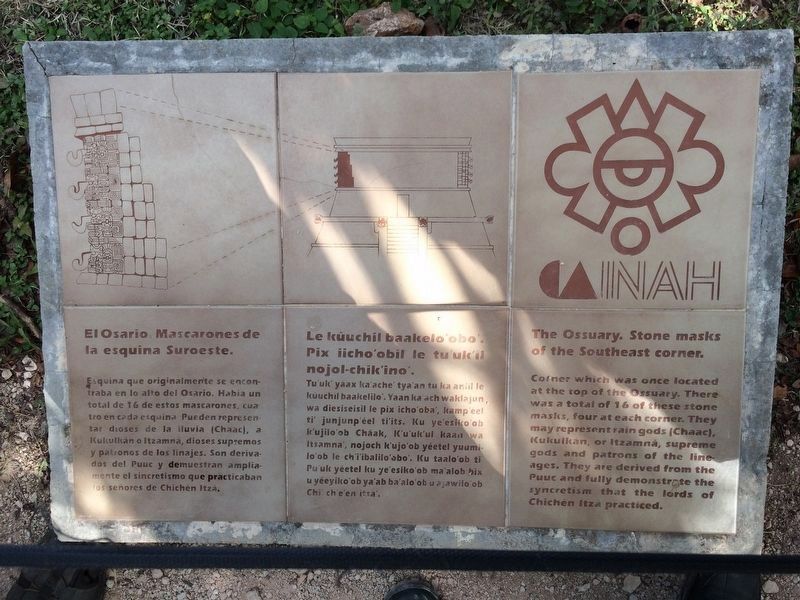
Photographed By J. Makali Bruton, January 17, 2017
2. An additional marker on the southwest corner of the Ossuary.
El Osario, Mascarones de la esquina Suroeste
Esquina que originalmente se encontraba en lo alto del Osario. Había un total de 16 de estos mascarones, cuatro en cada esquina. Pueden representar dioses de la lluvia (Chaac), a Kukulkán o Itzamná, dioses supremos y patronos de los linajes. Son derivados del Puuc y demuestran ampliamente el sincretismo que practicaban los señores de Chichén Itzá.
Le kúuchil baakelo’obo’. Pix iicho’obil le tu’uk’il nojol-chik’ino’.
Tu’uk yáax ka’ache’ tya’an tu ka’anil le kúuchil baakelilo’. Yaan ka’ach waklajun wa diesiseisil le pix icho’oba’, kamp’éel ti’ junjump’éel ti’its. Ku ye’esiko’ob k’ujilo’ob Cháak, K’u’uk’ul kaan wa Itsamna’, nojoch k’ujo’ob yéetel yuumilo’ob le chi’i’ibalilo’obo’. Ku taalo’ob ti Pu’uk yéetel ku ye’esiko’ob ma’alob bix u yéeyiko’ob ya’ab ba’alo’ob u a jawilo’ob Chi’ ch’e’en itza’.
The Ossuary. Stone masks of the Southeast (sic, Southwest) corner.
Corner which was once located at the top of the Ossuary. There was a total of 16 of these stone masks, four at each corner. They may represent rain gods (Chaac), Kukulkán, or Itzamná, supreme gods and patrons of the lineages. They are derived from the Puuc and fully demonstrate the syncretism that the lords of Chichén Itzá practiced.
Other nearby markers. At least 8 other markers are within walking distance of this marker. Platform of Venus and Round Platform (within shouting distance of this marker); Platform of the Tombs (within shouting distance of this marker); House of the Grinding Stones & House of the “Mestizas” (within shouting distance of this marker); Sacbeob 5 & 15 (about 180 meters away, measured in a direct line); Temple of Xtoloc (about 210 meters away); The Observatory (about 210 meters away); The Castle or Temple of Kukulcán (about 210 meters away); The Great Ball Court (approx. 0.3 kilometers away). Touch for a list and map of all markers in Pisté.
Credits. This page was last revised on March 12, 2017. It was originally submitted on March 12, 2017, by J. Makali Bruton of Accra, Ghana. This page has been viewed 226 times since then and 5 times this year. Photos: 1, 2, 3, 4, 5. submitted on March 12, 2017, by J. Makali Bruton of Accra, Ghana.
